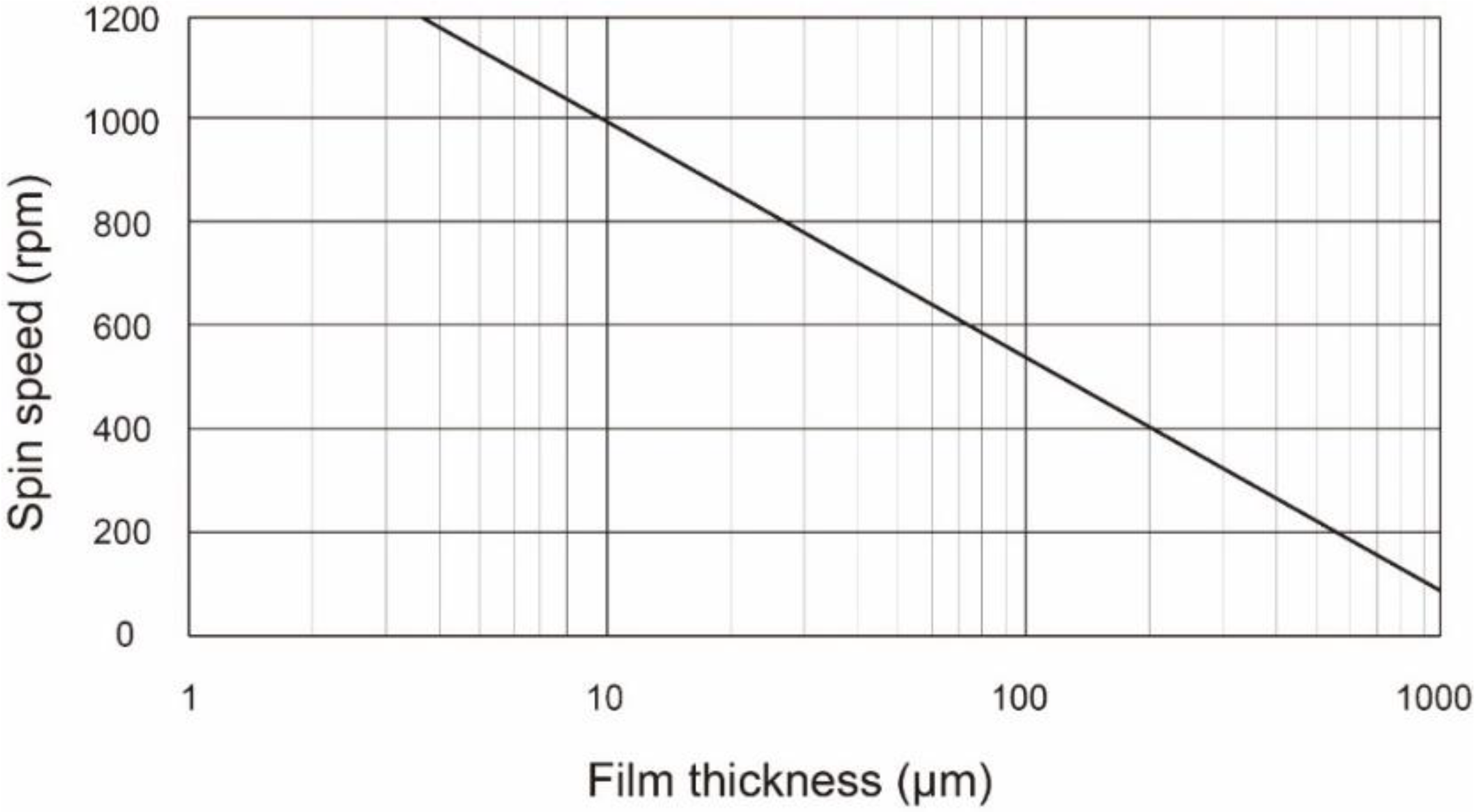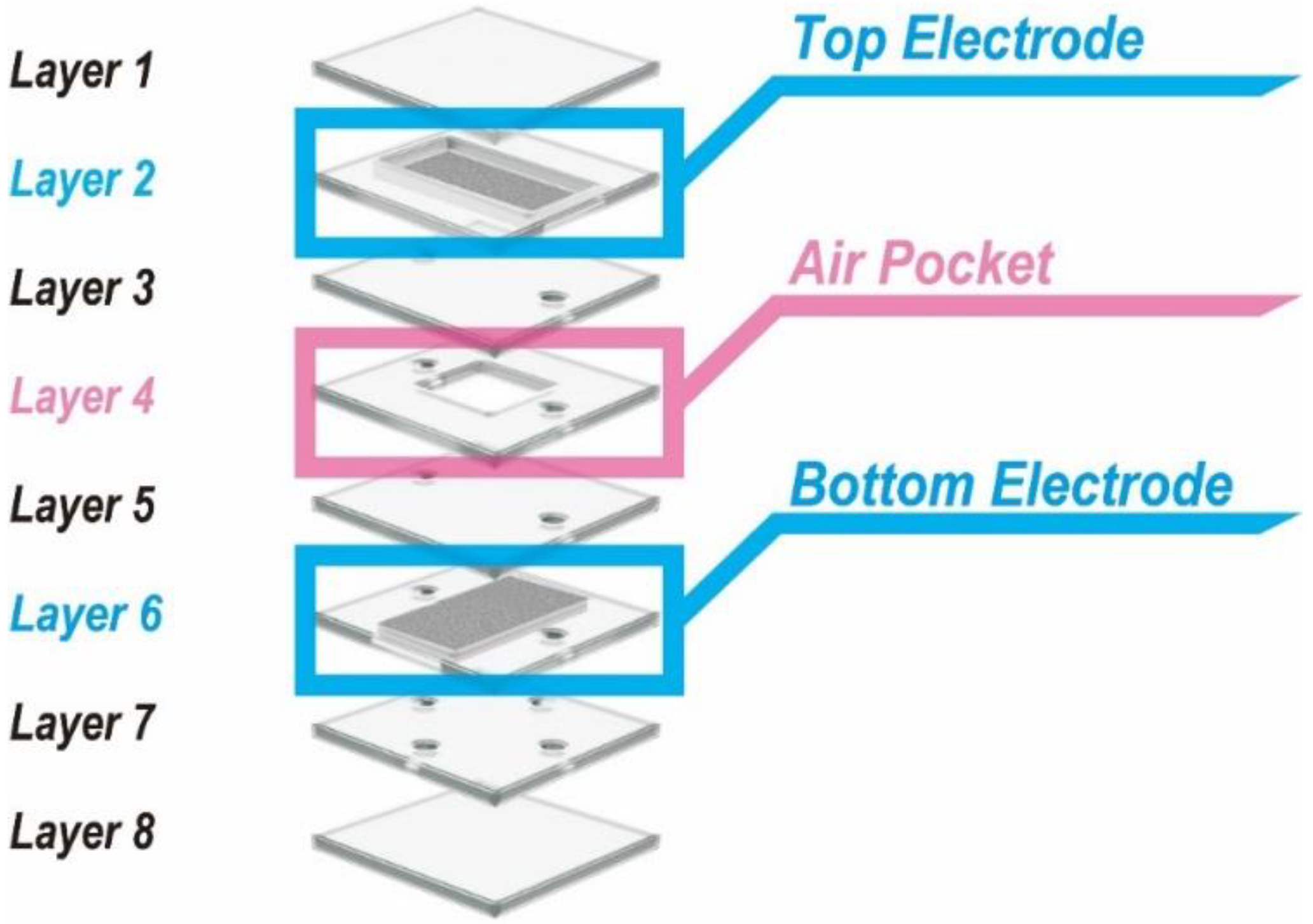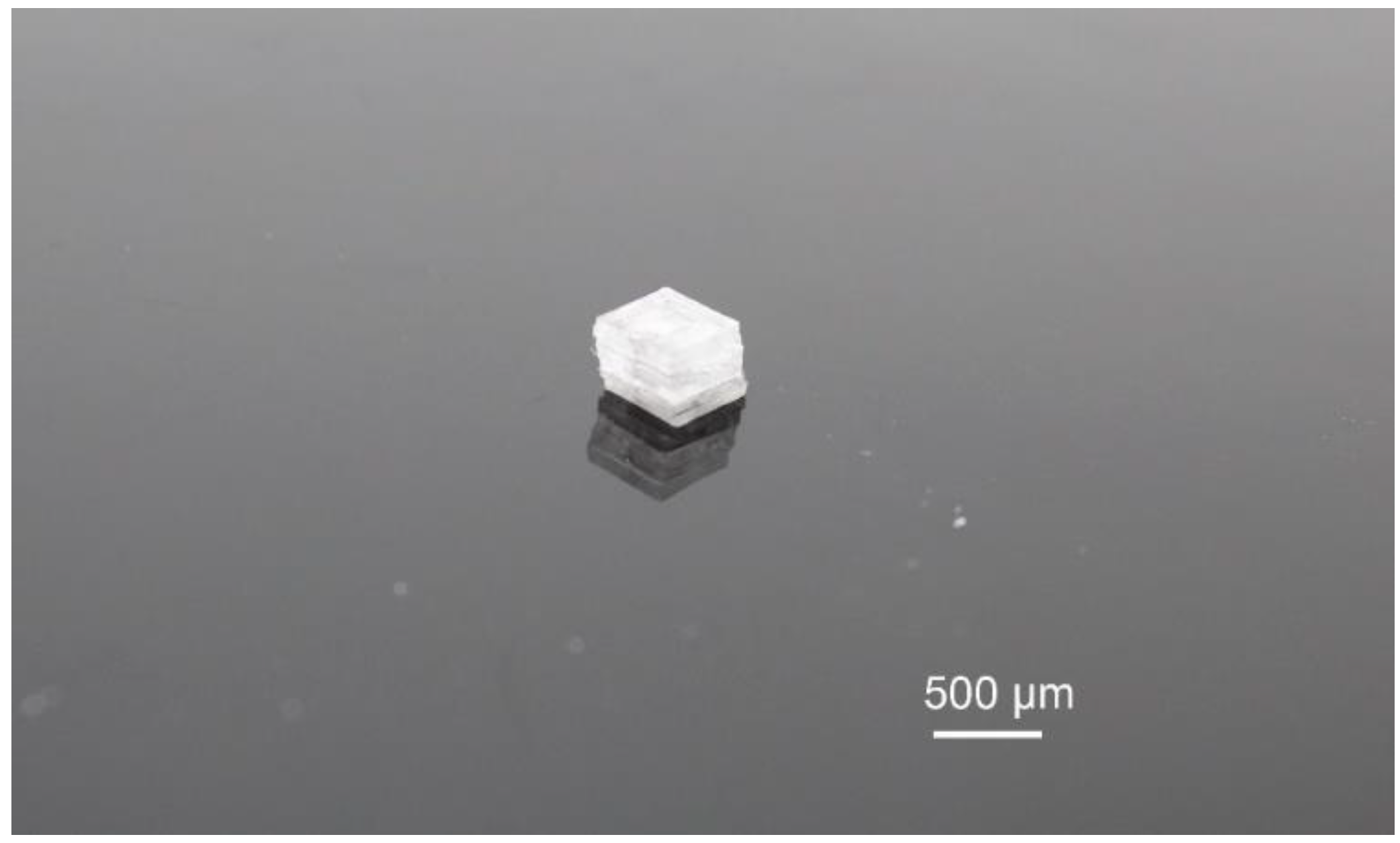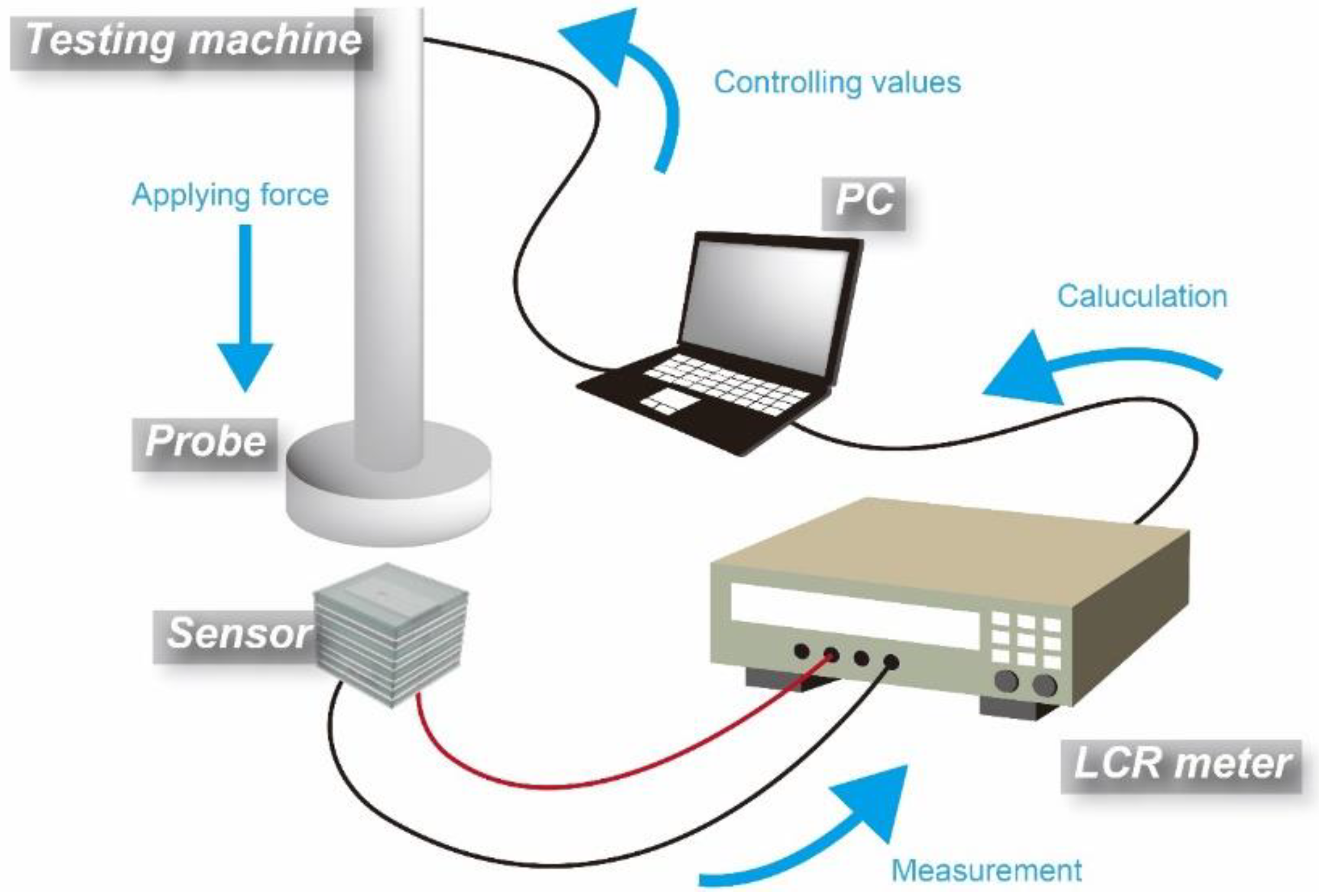Reduction of Parasitic Capacitance of A PDMS Capacitive Force Sensor
Abstract
:1. Introduction
2. Theory and Method
2.1. Theory
2.1.1. Parasitic Capacitance
2.1.2. Ultraviolet (UV) Treatment on Polydimethylsiloxane (PDMS) Porous Dielectrics
2.2. Method
2.2.1. UV Treatment on PDMS Membranes
2.2.2. Washing of PDMS Membranes
2.2.3. Periods While the Low Dielectric Constant of PDMS Membrane was Maintained
2.2.4. Fabrication Process of Capacitive Force Sensor
2.2.5. Comparison with UV-Washed, UV-Treated, and Noncoated Sensors
3. Results and Discussion
3.1. Change of the Dielectric Constant
3.1.1. Effect of UV Treatment
3.1.2. Effect of Washing
3.1.3. Stability of the Reduced Dielectric Constant of PDMS Membranes
3.2. Sensor Characteristics
4. Conclusions
Author Contributions
Funding
Conflicts of Interest
References
- Tiwana, M.I.; Redmond, S.J.; Lovell, N.H. A review of tactile sensing technologies with applications in biomedical engineering. Sens. Actuators Phys. 2012, 179, 17–31. [Google Scholar] [CrossRef]
- Hu, Y.; Katragadda, R.B.; Tu, H.; Zheng, Q.; Li, Y.; Xu, Y. Bioinspired 3-D Tactile Sensor for Minimally Invasive Surgery. J. Microelectromechanical Syst. 2010, 19, 1400–1408. [Google Scholar] [CrossRef]
- Yin, J.; Santos, V.J.; Posner, J.D. Bioinspired flexible microfluidic shear force sensor skin. Sens. Actuators Phys. 2017, 264, 289–297. [Google Scholar] [CrossRef]
- McKinley, S.; Garg, A.; Sen, S.; Kapadia, R.; Murali, A.; Nichols, K.; Lim, S.; Patil, S.; Abbeel, P.; Okamura, A.M.; et al. A single-use haptic palpation probe for locating subcutaneous blood vessels in robot-assisted minimally invasive surgery. In Proceeding of the 2015 IEEE International Conference on Automation Science and Engineering (CASE), Gothenburg, Sweden, 24–28 August 2015. [Google Scholar]
- Engel, J.; Chen, J.; Liu, C. Development of polyimide flexible tactile sensor skin. J. Micromech. Microeng. 2003, 13, 359–366. [Google Scholar] [CrossRef]
- Nishio, N.; Takanashi, H.; Tetsushi, M. Development of Hardness Sensor using Strain Gauge. In Proceeding of the Society of Instrument and Control Engineers Tohoku Chapter (SICE), Akita, Japan, 9 July 2010; Volume 259, pp. 1–5. [Google Scholar]
- Chen, Z.; Ren, W.; Gao, L.; Liu, B.; Pei, S.; Cheng, H.-M. Three-dimensional flexible and conductive interconnected graphene networks grown by chemical vapour deposition. Nat. Mater. 2011, 10, 424–428. [Google Scholar] [CrossRef] [PubMed]
- Samad, Y.A.; Li, Y.; Schiffer, A.; Alhassan, S.M.; Liao, K. Graphene Foam Developed with a Novel Two-Step Technique for Low and High Strains and Pressure-Sensing Applications. Small 2015, 11, 2380–2385. [Google Scholar] [CrossRef] [PubMed]
- Ota, H.; Chen, K.; Lin, Y.; Kiriya, D.; Shiraki, H.; Yu, Z.; Ha, T.-J.; Javey, A. Highly deformable liquid-state heterojunction sensors. Nat. Commun. 2014, 5. [Google Scholar] [CrossRef] [PubMed]
- Nakadegawa, T.; Ishizuka, H.; Miki, N. Three-axis scanning force sensor with liquid metal electrodes. Sens. Actuators Phys. 2017, 264, 260–267. [Google Scholar] [CrossRef]
- Nagatomo, T.; Miki, N. Three-axis capacitive force sensor with liquid metal electrodes for endoscopic palpation. IET Micro Nano Lett. 2017, 12, 564–568. [Google Scholar] [CrossRef]
- Zhang, P.; Wan, Q.; Feng, C.; Wang, H. All Regimes Parasitic Capacitances Extraction Using a Multi-Channel CBCM Technique. IEEE Trans. Semicond. Manuf. 2017, 30, 121–125. [Google Scholar] [CrossRef]
- Sun, L.-J.; Cheng, J.; Ren, Z.; Shang, G.-B.; Hu, S.-J.; Chen, S.-M.; Zhao, Y.-H.; Zhang, L.; Li, X.-J.; Shi, Y.-L. Extraction of geometry-related interconnect variation based on parasitic capacitance data. IEEE Electron Device Lett. 2014, 35, 980–982. [Google Scholar] [CrossRef]
- Hebedean, C.; Munteanu, C.; Racasan, A.; Pacurar, C. Parasitic capacitance removal with an embedded ground layer. In Proceedings of the Eurocon 2013, Zagreb, Croatia, 1–4 July 2013; IEEE: Zagreb, Croatia, 2013; pp. 1886–1891. [Google Scholar]
- Martinez, E.; Rochat, N.; Guedj, C.; Licitra, C.; Imbert, G.; Le Friec, Y. Influence of electron-beam and ultraviolet treatments on low-k porous dielectrics. J. Appl. Phys. 2006, 100, 124106. [Google Scholar] [CrossRef]
- Kao, K.-C.; Chang, W.-Y.; Chang, Y.-M.; Leu, J.; Cheng, Y.-L. Effect of UV curing time on physical and electrical properties and reliability of low dielectric constant materials. J. Vac. Sci. Technol. Vac. Surf. Films 2014, 32, 061514. [Google Scholar] [CrossRef]
- Miwa, S.; Ohtake, Y. Chemical Changes in Cross-linked Silicone Rubber by Ozone-water Treatments. Nippon Gomu Kyokaishi 2014, 87, 161–167. [Google Scholar] [CrossRef] [Green Version]
- Meyerhofer, D. Characteristics of resist films produced by spinning. J. Appl. Phys. 1978, 49, 3993–3997. [Google Scholar] [CrossRef]
- Haas, D.E.; Quijada, J.N.; Picone, S.J.; Birnie, D.P. Effect of solvent evaporation rate on skin formation during spin coating of complex solutions. Proc. SPIE 2000, 3943, 280–284. [Google Scholar] [Green Version]
- Emslie, A.G.; Bonner, F.T.; Peck, L.G. Flow of a Viscous Liquid on a Rotating Disk. J. Appl. Phys. 1958, 29, 858–862. [Google Scholar] [CrossRef]
- Wu, H.; Huang, B.; Zare, R.N. Construction of microfluidic chips using polydimethylsiloxane for adhesive bonding. Lab Chip 2005, 5, 1393. [Google Scholar] [CrossRef] [PubMed]
- Taguchi, G. Quality Engineering (Taguchi Methods) For The Development Of Electronic Circuit Technology. IEEE Trans. Reliab. 1995, 44, 225–229. [Google Scholar] [CrossRef]
- Anderson, J.H.; Parks, G.A. Electrical conductivity of silica gel in the presence of adsorbed water. J. Phys. Chem. 1968, 72, 3662–3668. [Google Scholar] [CrossRef]
- Bodas, D.; Khan-Malek, C. Formation of more stable hydrophilic surfaces of PDMS by plasma and chemical treatments. Microelectron. Eng. 2006, 83, 1277–1279. [Google Scholar] [CrossRef]
- Mata, A.; Fleischman, A.J.; Roy, S. Characterization of Polydimethylsiloxane (PDMS) Properties for Biomedical Micro/Nanosystems. Biomed. Microdevices 2005, 7, 281–293. [Google Scholar] [CrossRef] [PubMed]










© 2018 by the authors. Licensee MDPI, Basel, Switzerland. This article is an open access article distributed under the terms and conditions of the Creative Commons Attribution (CC BY) license (http://creativecommons.org/licenses/by/4.0/).
Share and Cite
Nagatomo, T.; Miki, N. Reduction of Parasitic Capacitance of A PDMS Capacitive Force Sensor. Micromachines 2018, 9, 570. https://doi.org/10.3390/mi9110570
Nagatomo T, Miki N. Reduction of Parasitic Capacitance of A PDMS Capacitive Force Sensor. Micromachines. 2018; 9(11):570. https://doi.org/10.3390/mi9110570
Chicago/Turabian StyleNagatomo, Tatsuho, and Norihisa Miki. 2018. "Reduction of Parasitic Capacitance of A PDMS Capacitive Force Sensor" Micromachines 9, no. 11: 570. https://doi.org/10.3390/mi9110570




